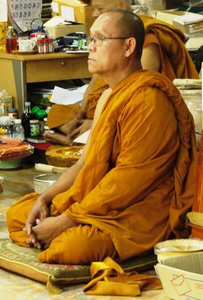Advertisement
Published: October 6th 2010

 It's a tough job.....
It's a tough job.....
..but someone has to be on duty to receive the punters and the donations.Gleaming gold and red temples, huge golden statues of the Buddha, the smell of incense, grave-faced monks chanting the sutras in Pali, lines of reverent worshippers sitting in
'samadhi', the occasional slow booming sound of a gong.
This is the picture most travellers have of Thai Buddhism, and to an extent it is a true reflection as an earlier post of mine on the subject shows (July 19th). But it's not the entire picture and may not be close enough to the reality of how the religion is practised up-country and by people beyond the main
wats (temples) that attract the tourists.
Last week my family visited
Wat Tung Hiang between Chachoengsao and Chonburi, about 100 kilometres due east of Bangkok along Route 314. Thailand is densely populated with wats which in a sense represent a Christian parish church or perhaps a Jewish synagogue or Islamist mosque - but I would argue a little more "real" and probably more useful than any of these. Monks establish a wat on donated or acquired ground and gradually build up a religious "business" catering to the spiritual and often physical needs of the community. For some reason, perhaps because of the

 Buddha Shop
Buddha Shop
This is where the community comes, to buy amulets, make donations and to see the Duty Monk(s) who is inside.beautiful Bang Pakong River, the environs of Chachoengsao have more than their fair share of these establishments.
Wat Tung Hiang caters for orphans. It is not the most beautiful of wats, nor the best kept and the monks are a little careworn and occasionally grouchy. People wander in and out of their "shop" buying
amulets, asking for a blessing and bringing food and toiletries to make merit or
tam boon, literally to "make good". The monks exist on these donations and revenue from amulet sales. There are usually a couple of monks on duty to service the customers. In a typical Thai way it's all very pragmatic; you wait your turn, kneel,
wai phra or bow three times and dump your offering, large or small, on a mat in front of the sitting monk. He'll then chant a few phrases, perhaps sprinkle some water over your head and maybe tie a good luck knot around your wrist. You bow three times again, and you're done for the day or the week or however long it takes for the merit to wear thin again. Meantime, other folk are walking around, chatting, window shopping the amulets and Buddha images for sale,

 You gotta eat
You gotta eat
The Duty Monks take their mid-day meal (the last of the day), laid out by visitors (in this case my family) who have brought the food to make merit. taking photos if (like me) they're occasional visitors or simply hanging out.
There's nothing very mystical or mysterious or even very spiritual about all this. Thais are indeed the most pragmatic of people and Buddhism seems to offer straight, easy to understand bargain; visit the wat (
pai tam boon) 5 minutes with the presiding monk, make a donation and you're done. For the monks this is a good livelihood and the Buddhist community (
Sangha) is a HUGE money-making machine that employs hundreds of thousands countrywide. Not only does it service the spiritual or let's say psychological needs of the community but it provides education for the young, in this case but not necessarily, orphans and a sanctuary for the old or those with time on their hands or an outlet for folks simply wanting to do good.
I'll take up the business angle in another post, but for now, I'm impressed with the "realness" of this approach to religion. It doesn't concern itself too much with the metaphysical, and even the chanted sutras are in Pali so not understood by ordinary people (and not all the monks). It is, like all religions, a money-making enterprise of immense power,

 Out from school
Out from school
Wat Tung Hiang takes care of more than 100 orphans, all funded from donationsbut unlike others religions, the wat is a welcome, central and living part of all Thai communities for both young and old, rich and poor alike and unless you understand that, you miss one of the key elements in what it means to be Thai.
Wat Tung Hiang, Chonburi District, Phanat Nikom, Thailand
Advertisement
Tot: 0.271s; Tpl: 0.019s; cc: 21; qc: 131; dbt: 0.1463s; 1; m:domysql w:travelblog (10.17.0.13); sld: 1;
; mem: 1.4mb

 It's a tough job.....
It's a tough job.....
 Buddha Shop
Buddha Shop
 You gotta eat
You gotta eat
 Out from school
Out from school

Rob_n_Lorenza
Rob & Lorenza B
interesting blog .... I am also impressed by the "realness" well put